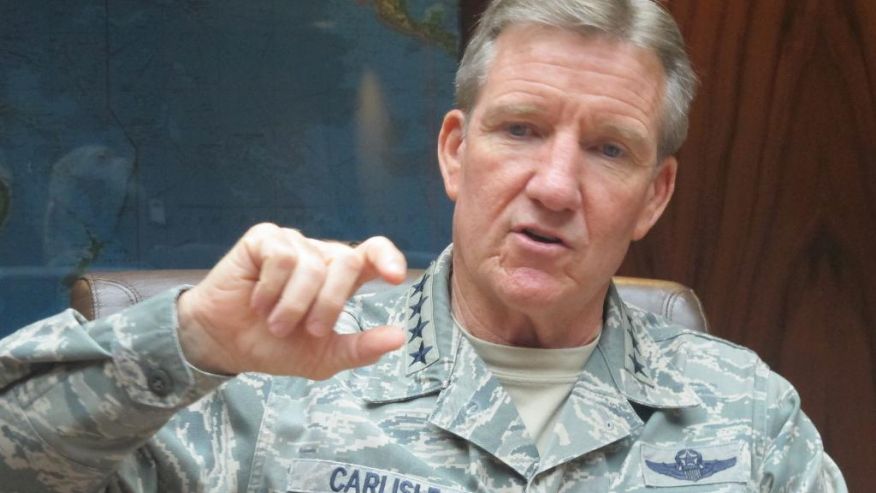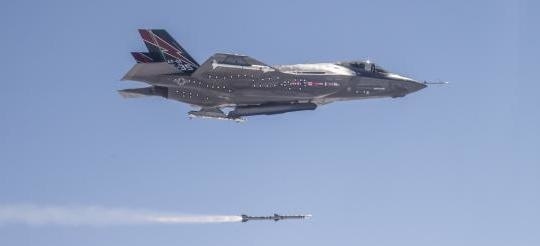Hawk Carlisle On The Way Ahead: DE, EW, Data
Posted on
 Gen. Hawk Carlisle has been at the center of global allied operations for several years, first at Pacific Air Forces and now at Air Combat Command. Recently, we interviewed him at Langley AFB, home of Air Combat Command. During his watch, several new combat assets have come to play in Middle East operations. “Each of the new assets – the F-22, the Typhoon, the Wedgetail and the KC-30A – have performed well. They have proven once again that if you get new assets into the hands of the young men and women in the force that amazing things can happen. The platforms have been pushed to a level that we could not guess at prior to real world operations.”
Gen. Hawk Carlisle has been at the center of global allied operations for several years, first at Pacific Air Forces and now at Air Combat Command. Recently, we interviewed him at Langley AFB, home of Air Combat Command. During his watch, several new combat assets have come to play in Middle East operations. “Each of the new assets – the F-22, the Typhoon, the Wedgetail and the KC-30A – have performed well. They have proven once again that if you get new assets into the hands of the young men and women in the force that amazing things can happen. The platforms have been pushed to a level that we could not guess at prior to real world operations.”
https://youtu.be/IXCsC9tzCug
The challenge is to enhance network integration at the same pace as new assets are introduced.
“We’ll make even more progress when we get to the link architecture and the translators that allow us to truly achieve fifth-to-fourth, and fourth-to-fifth (generation) integration and to take National Technical Means (what most people call spy satellites) and bring that into the fight as well,” Carlisle says.
So far allied air forces are not taking advantage of all the data fifth generation fighters such as the F-22 are gathering. “We’re not off-boarding everything from the F-22 and F-35 that we should. There’s a wealth of information on those platforms that never gets taken advantage of. However, we are working to ensure that we position ourselves to do so,” Carlisle believes.
In addition to the data from fifth generation aircraft, Carlisle says they, “are clearly working hard on integration of missile defense with our strike assets as well. For example, we have made significant steps in the Pacific where we can better integrate area defense for the Carrier Strike Groups and defend our airbases as well.”
A key issue is to marry the significant sensor capabilities of the joint force with more cost-effective and new forms of strike. Carlisle linked the evolution of Directed Energy with the evolving capabilities for the kill web.
“We know how to do hit-to-kill and our sensor and C2 packages are getting better. We just need to enhance the technology, which provides us with the low-cost, high-magazine and high-accuracy systems to go along with the sensor grid,” Carlisle said. “Directed Energy weapons are clearly part of the transition. We will be putting one on an F-15 for test purposes before long. The first thing we are going to do with it is defensive, in particular against a SAM (surface to air missile).”

The F-35 in particular brings a level of commonality and collaboration to the joint force, which is a significant driver of change. “Assuming the Canadians buy the F-35, we will see even closer integration among the Five Eye nations. We will shape a level of synergy among those air forces that exceeds anything we have done before,” Carlisle said.
Many years ago former Air Force Secretary Wynne discussed how the F-22 and F-35 would affect the traditional AWACS role in favor of new approaches to C2 in the battlespace. The operations in the Middle East have clearly demonstrated the change.
Carlisle noted the F-22 is allowing use of “sensor fusion on board the aircraft to pass information to the rest of the force, which is bringing their game up as well. The F-22 functions in this sense as a battle manager because the pilot has the SA (situational awareness) inside his cockpit to direct other aircraft on what they do and how they can do it more effectively. We are better at this now than we were even a year ago.”
That makes life more complicated “for an adversary when you have multiple places from which you can strike. You have the SA and the information shared among all three platforms in the case of the trilateral exercise. You couldn’t defend against all of them.”
Finally, we discussed a key area for growth in fighter and other aircraft capabilities in the years to come, namely the next phase of significant evolution in the capabilities of missiles informed by the distributed warfighting capabilities of the fifth generation enabled air combat force.
Carlisle closed the interview discussing the dynamic of weapons development, effectively saying that fifth generation aircraft need fifth generation weapons, both kinetic, DE and electronic.
“There is a clear need for new weapons. We need range; we need magazine depth; we need broad-spectrum capabilities. We need to be able to do a central sweep that can cover the spectrum that’s not defined by medium range, or medium-wave IR, or X Band, but rather can cover the IR spectrum potentially in the EO/IR, and potentially the RF spectrum as well. Besides the networking and the architecture that we haven’t shaped to the level that we want to, the next thing is we have great fifth-generation capability with fourth-gen weapons, and that doesn’t make sense.
“I don’t need a new point-and-shoot weapon,” he said. “I just want a look and shoot, and I want unlimited magazine depth. I want scalable effects so that based on what the environment is I can change the weapon’s effect to protect friendlies.”
In short, for the ACC Commander, the future is now but at the same time, he needs to weave new assets into an ongoing transformation.
Subscribe to our newsletter
Promotions, new products and sales. Directly to your inbox.
